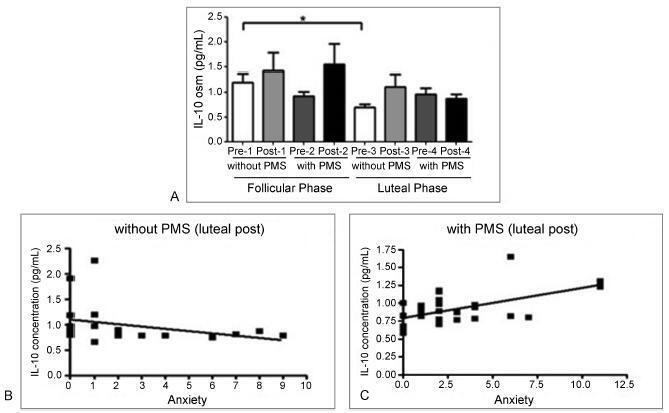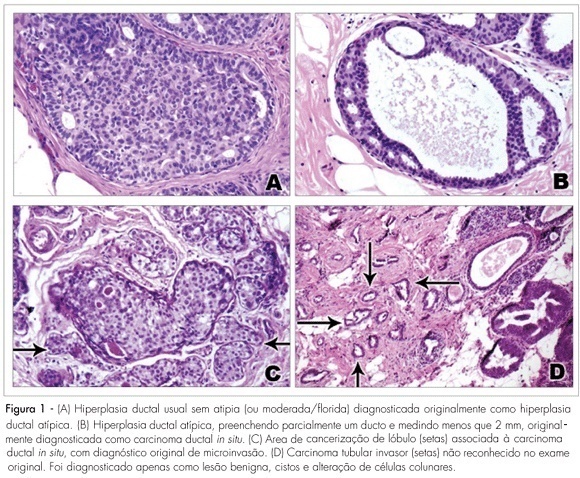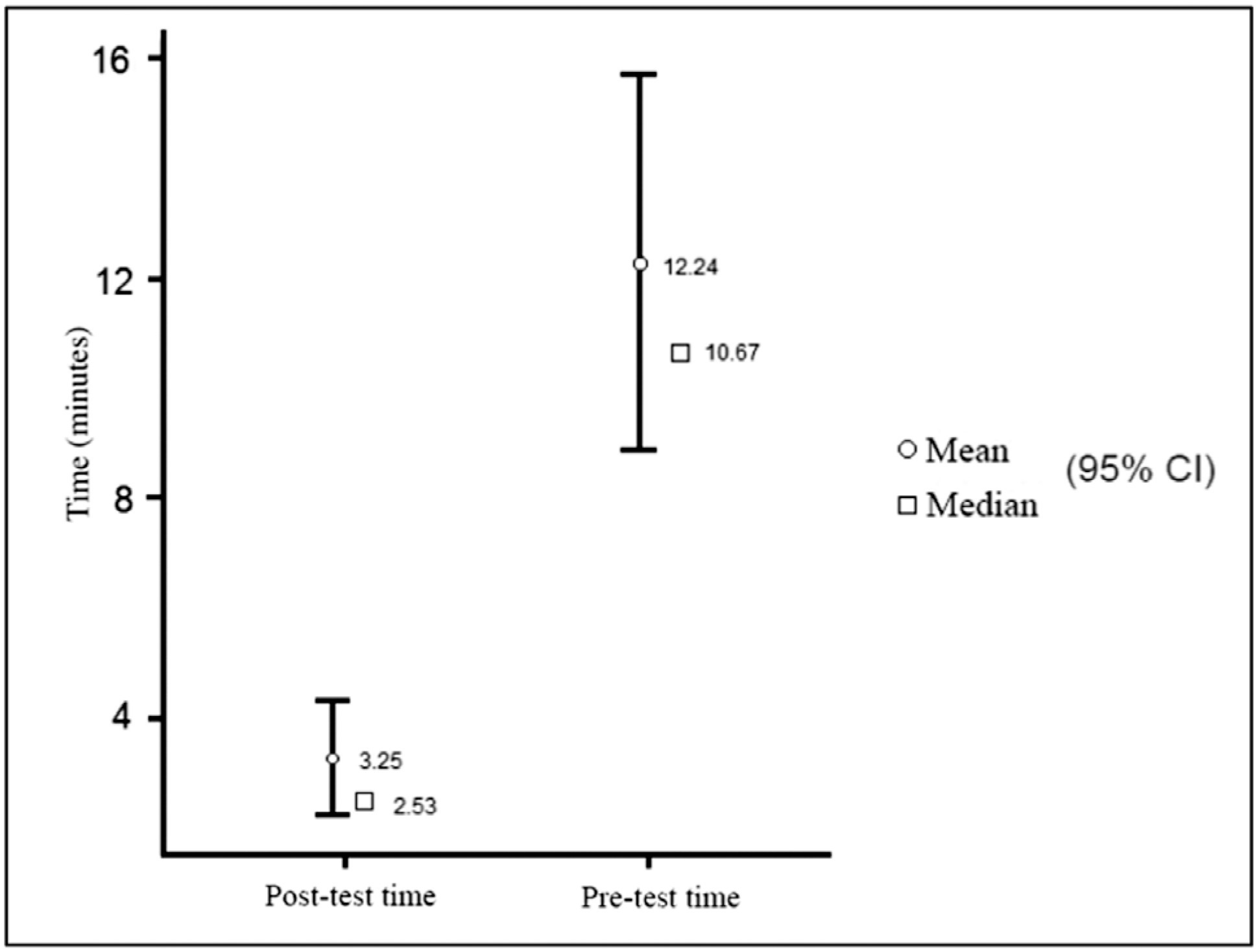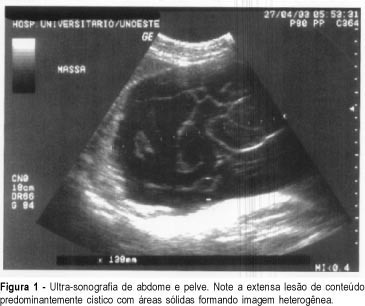Summary
Revista Brasileira de Ginecologia e Obstetrícia. 2017;39(11):602-607
To investigate the level of anxiety and its relationship with interleukin (IL)- 10 (anti inflammatory cytokine that modulates mood swings) in a group of female soccer players.
Fifty-two eumenorrheic soccer players were evaluated (age 19.8 ± 4.7 years). The presence of premenstrual syndrome (PMS) and phases of the menstrual cycle were determined by a daily symptomreport (DSR) kept for 3 consecutivemonths. The concentration of cytokine IL-10 was determined from urine samples collected at four moments: at the follicular and luteal phases of the menstrual cycle, and before (pre) and after (post) the simulated game, and it was quantified by flow cytometry (Luminex xMAP - EMDMillipore, Billerica, MA, USA). The level of anxietywas determined through the BAI anxiety questionnaire answered by all athletes at the same time of the urine collection. The Student t-test, analysis of variance (ANOVA) and Pearson correlation with significance level at 5% were used for data analysis.
We showed that the prevalence of PMS among female soccer players is similar to that reported in the literature. In addition,we showed that the group withPMS has a higher level of anxiety compared with group without PMS (p = 0.002). Interleukin-10 analysis in players without PMS revealed that there was a significant decrease in the level of this cytokine before the game during the luteal phase when compared with the follicular phase (p < 0.05). The correlation analysis between IL-10 and anxiety showed a negative correlation post-game in the luteal phase in the group without PMS (p = 0.02; r = -0.50) and a positive correlation post-game in the luteal phase in PMS group (p = 0.04; r = 0.36).
Our results suggest that IL-10 may contribute to reduce anxiety in the group without PMS. This could be attributed to the fact that no IL-10 variation was observed in the group with PMS, which presented higher anxiety symptoms when compared with the group without PMS.

Summary
Revista Brasileira de Ginecologia e Obstetrícia. 2010;32(12):602-608
DOI 10.1590/S0100-72032010001200007
PURPOSE: to prospectively evaluate the effects of immediate breast reconstruction on the quality of life of women who underwent mastectomy. METHODS: 76 women that underwent mastectomy at Centro de Atenção Integral à Saúde da Mulher da Universidade Estadual de Campinas, in Campinas, São Paulo, Brazil, from August 2007 to December 2008, were included. Two groups were formed: 41 women who underwent mastectomy combined with immediate breast reconstruction (M+RI) and 35 that were subjected to mastectomy alone (M). The quality of life evaluation was assessed with the World Health Organization's questionnaire - Quality of Life (WHOQOL-100). The questionnaire was administered on three occasions: at the time of admission, one month after surgery, and again six months after surgery. The WHOQOL-100 scores were calculated according to analysis' guidelines by the World Health Organization. For comparison of the scores between groups, it was used the Student's t-test, Fisher exact test, chi-square test, and Mann-Whitney test. For the analysis of repeated measures over time, ANOVA and ANOVA for repeated measures were used. RESULTS: at all time points evaluated, beginning with the preoperative assessment, the average quality of life scores of the M+IR Group were higher than those of the M Group, primarily in the "physical", "psychological", "level of independence" and "social relationships" domains of the questionnaire. Of the six areas covered by the questionnaire, three ("physical", "social relations", "environment") showed no significant differences between groups. The M+IR Group had a better score (15.5 to 14.9 for the M+IR and 14.3 to 14.2 for M; p=0.04) in the psychological domain. There was a significant reduction in the level of independence in the first month after surgery in both groups, with a significant recovery after six months. CONCLUSIONS: the present results suggest that immediate breast reconstruction is significantly beneficial regarding the psychological aspects of quality of life, without affecting the patient's physical functionality.
Summary
Revista Brasileira de Ginecologia e Obstetrícia. 2008;30(12):602-608
DOI 10.1590/S0100-72032008001200003
PURPOSE: to evaluate the agreement between histopathologic diagnoses of breast lesions made by general pathologists and by a specialist in breast pathology. METHODS: a cohort retrospective study comparing histopathologic diagnoses of 329 cases of breast lesions received in consultation for a second opinion was carried out. The material received for consultation included slides (152 cases), paraffin blocks (59 cases) or slides and blocks (118 cases). Cases were reviewed and the original diagnoses and diagnoses from a specialist in breast pathology were compared. The main diagnoses, nuclear grade of ductal carcinoma in situ, and the histopathologic grade of invasive mammary carcinomas were evaluated. The kappa index and percentual concordance were used in the statistical analyses. RESULTS: a moderate agreement was observed between the original histopathologic diagnoses and the second opinion (kappa index=0.48; percentual concordance=59.9%). The diagnosis of malignancy was confirmed in 185/225 cases (82.2%) and diagnosis of benign lesions was confirmed in 89/104 cases (85.6%). The highest agreement was observed in the diagnosis of invasive mammary carcinomas (81%) and the highest disagreement was observed among diagnoses of ductal carcinoma in situ with microinvasion (74%), lobular carcinoma in situ (70%), and atypical epithelial hyperplasias (61%). There was a moderate agreement in the nuclear grade of ductal carcinoma in situ (kappa index=0.52; percentual concordance=68.8%), and good concordance in the histologic grade of invasive carcinomas (kappa index=0.61; percentual concordance=74.3). CONCLUSIONS: the results show higher concordance rate in the diagnosis of invasive carcinomas and lower concordance in the diagnosis of ductal carcinoma in situ with microinvasion and premalignant breast lesions, especially lobular neoplasia in situ, and atypical epithelial hyperplasias.

Summary
Revista Brasileira de Ginecologia e Obstetrícia. 2022;44(6):602-608
The aim of the present study is to list the published clinical trials on coronavirus disease 2019 (COVID-19) vaccines, to describe the mechanism of action of the identified vaccines, and to identify protocols regarding safety, status, and prioritization of cancer patients for vaccination.
This is a systematic review with a limited literature search conducted by an information specialist; key resources such as PubMed and websites of major cancer organizations were searched. The main search terms were COVID-19, vaccination, cancer, and breast and gynecological cancers.
Cancer patients infected with the new coronavirus are at high risk of complications and death, but we still know little about the risks and benefits of vaccination for COVID-19 in these patients. In an ideal scenario, all cancer patients should have their immunization status updated before beginning treatment, but this is not always possible.
Patients with breast or gynecological cancers who are receiving treatment or are in the 5-year posttreatment period should be included in the priority group for severe acute respiratory syndrome coronavirus-2 (SARS-CoV-2) vaccination.
Summary
Revista Brasileira de Ginecologia e Obstetrícia. 2023;45(10):603-608
To evaluate the performance of residents in gynecology and obstetrics before and after practicing laparoscopic sutures, to establish when the training shows the best results, in addition to comparing whether being in different years of residency influences this progression.
A prospective cohort study involving 32 medical residents evaluated with a pretest to establish their previous knowledge in laparoscopic suture. This test consisted of knotting two wires, one made of polypropylene and the other of polyglactin, with a blocking sequence of five semi-knots. We set a 30-minute limit to complete the task. Then, the residents held four training meetings, focusing on suture, Gladiator rule, knot, and symmetries, in addition to executing blocking sequences. A second test to establish progress was performed.
Regarding the time spent to make the stiches using polyglactin wire, a statistically significant time improvement (p< 0.01) was observed, with a 10.67-minute pretraining median (mean 12.24 minutes) and a 2.53-minute posttraining median (mean 3.25 minutes). Regarding the stitches with polypropylene wire, a statistically significant time improvement (p< 0.05) was also observed, with a 9.38-minute pretraining median (mean 15.43 minutes) and a 3.65-minute posttraining median (mean 4.54 minutes). A total of 64.2% of the residents had been able to make the knot with polypropylene previously. One hundred percent were able to complete the task in the posttest.
Model training using the Gladiator rule for laparoscopic suture improves the knotting time with statistically similar performance, regardless of the year of residency, after systematic training.

Summary
Revista Brasileira de Ginecologia e Obstetrícia. 1999;21(10):603-605
DOI 10.1590/S0100-72031999001000007
The cryopreservation of embryos in late developing stages seems to present satisfactory results. With the purpose of better testing the embryos' survival, they were cryopreserved in the morula or blastocyst stage, thawed and left in culture for 24 hours so that their natural evolution could be observed. Amongst the frozen 2 blastocysts and 5 morulas, 4 morulas survived the thawing process, being transferred as blastocysts 24 hours later. The transfer was performed in a young patient, second marriage of a ten-year vasectomized man and resulted in twin pregnancy. Thawing morula embryos and the in vitro observation of their development resumption until the blastocyst stage give us an additional parameter in the quality evaluation of the embryo and probably an improvement in pregnancy rates.
Summary
Revista Brasileira de Ginecologia e Obstetrícia. 2009;31(12):604-608
DOI 10.1590/S0100-72032009001200005
PURPOSE: to evaluate the results of treatment to which patients with high grade intraepithelial cervical neoplasia (HSIL) are submitted, as well as their follow-up during pregnancy. METHODS: retrospective study based on the review of the medical report of 30 patients with diagnosis of high-grade squamous intraepithelial lesions (HSIL) during pregnancy and attended to at a tertiary hospital in southern Brazil from 1990 to 2002. Diagnosis was performed by colposcopy and biopsy, with repetition of the colposcopy during the pregnancy and after delivery. The diagnoses of regression and progression of lesions were evaluated. RESULTS: from 30 patients, 3 were excluded of the sample because the diagnosis of high-grade squamous intraepithelial lesions (HSIL) was not confirmed by the colposcopy with biopsia. Four patients were submitted to treatment during pregnancy, and one of them presented preterm delivery at the 32nd week. Twenty-three patients were submitted to expectant treatment, underwent a new colposcopy and biopsy, and then were submitted to conisation surgery at about the 11th week after the end of pregnancy. In 7.4% of the cases, there was lesion regression in the surgical specimen. CONCLUSIONS: all patients with diagnosis should be submitted to colposcopy and biopsy to exclude the possibility of invasive lesion. The expectant procedure for intraepithelial lesions is the most widely chosen and safe due to the possibility of regression in the postpartum period.
Summary
Revista Brasileira de Ginecologia e Obstetrícia. 2003;25(8):605-608
DOI 10.1590/S0100-72032003000800010
The purely mucinous tumors of the ovary are considered, by some authors, as a monodermic variant of mature teratoma. Few case reports mention the coexistence of these two tumors with distinct cellular origin. Our objective is to describe the case of a 38-year-old patient with a mucinous cystadenocarcinoma with low malignant potential arising in a mature cystic teratoma and to divulge the importance of the knowledge about this association to the gynecological surgeon.
